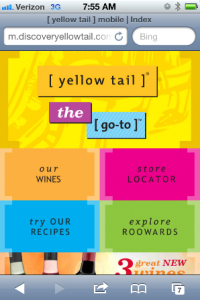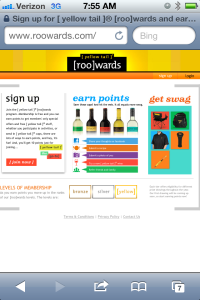Yellow Tail Wine, QR Codes, and Mobile Brand Interaction
Posted on by Timothy Boyle As a brand it should be your goal to try and have customers interact with said brand as often as possible, and that such interaction is of high quality. Doing this means greater familiarity is built between the customer and the brand, and it can in time create a sort of emotional tie between the two, this in turn should then help to increase future sales. One problem is finding a means to connect with customers and entice them to interact, luckily a simple tool exists to help ensure this interaction: QR codes.
As a brand it should be your goal to try and have customers interact with said brand as often as possible, and that such interaction is of high quality. Doing this means greater familiarity is built between the customer and the brand, and it can in time create a sort of emotional tie between the two, this in turn should then help to increase future sales. One problem is finding a means to connect with customers and entice them to interact, luckily a simple tool exists to help ensure this interaction: QR codes.
A recent personal example might help illuminate how this sort of interaction can be done using QR codes as your tool to accomplish the goal.
I had purchased a bottle of the wine Yellow Tail and when I proceeded to open it later that evening I saw that on the back label there was a QR code. Unfortunately there was no call-to-action (I will discuss this later), but considering I write about QR codes regularly I figured I would scan it and see where it took me.
Surprisingly—considering their lack of a call-to-action—I was impressed with what I found. Not only were they getting the technical aspects down—their page was mobile optimized—but they had a great way to incentivize customers to interact with their brand in addition to providing them with information that might also want.
 Besides having a store locator, a list of all their wines, and a favorite recipe list, most importantly they had a rewards section where you could save Yellow Tail bottle caps and get points that you can accrue to buy various Yellow Tail swag.
Besides having a store locator, a list of all their wines, and a favorite recipe list, most importantly they had a rewards section where you could save Yellow Tail bottle caps and get points that you can accrue to buy various Yellow Tail swag.
This is a perfect way to incentivize customers to interact with you brand and feel like they are getting something in addition to just the particular product they are consuming. This sort of interaction and rewards program is a great way to create a loyal customer who will more than likely make future purchases.
The only problem I found here is that lack of a call-to-action adjacent to the code (i.e. giving customers a clear reason/incentive to scan the code). This is a very big problem however, particularly because everything else was done so well.
If you are using a QR code then it is obvious you would also want people to actually scan said code. But most people are not going to waste the time scanning the code if they are not guaranteed to find something of interest on the other end. Having a QR code without a call-to-action fails to provide the information most people need if they are going to decide to scan your code.
It is vitally important, particularly if you have something as great for brand interaction as a rewards program, to explain what the benefit is to scanning said QR code. Convince people to scan the code, tell them why it is worth their time, and make sure it is. Once this is done, and they have also been provided with positive brand interaction, said QR code campaign will be a success.
QR codes can be a great tool to reach many objectives, but whatever your reason for using them, just be sure you are using them correctly.

